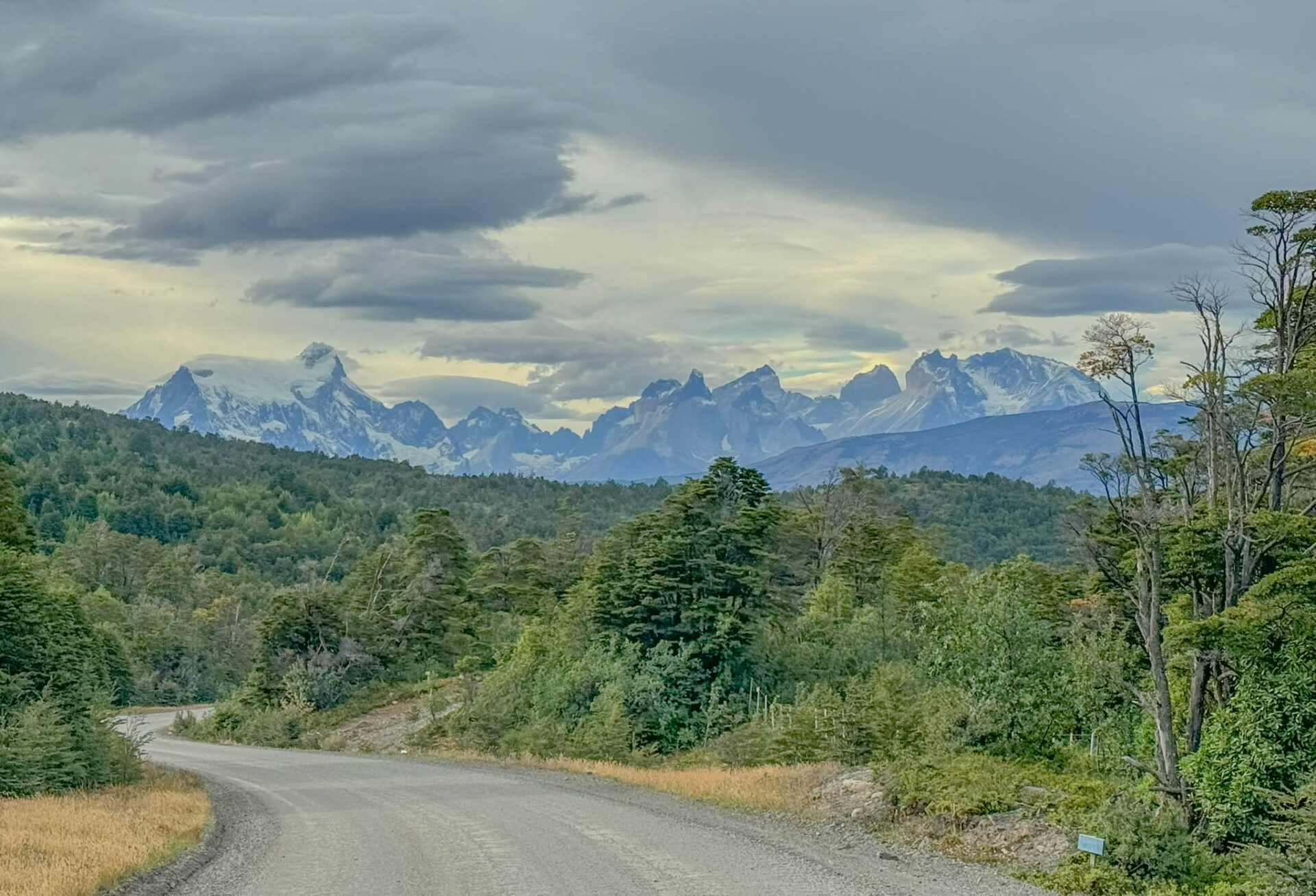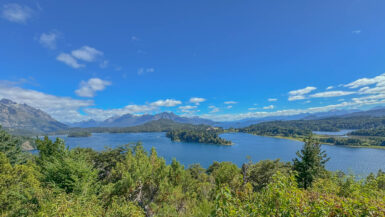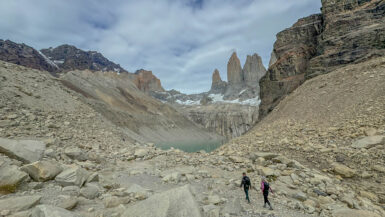Travel advice for driving a rental car from El Calafate, Argentina to Torres del Paine, Chile, and back.
If you’re planning a trip that includes renting a car to explore the southern Patagonia region of both Argentina and Chile, this article will help you plan a drive between two major destinations: El Calafate, Argentina and Torres del Paine, Chile.
In case you aren’t familiar with those places, the city of El Calafate is known as the “gateway to glaciers”, such as Perito Moreno Glacier in Los Glaciares National Park. Many people consider Torres del Paine to be the best place to visit in the Chilean Patagonia region. Torres del Paine is a beautiful place that’s home to some of the most famous big hikes in South America, so it’s an ideal place to visit if you’re looking to hit the trails.
Driving from El Calafate to Torres del Paine could be a bit more adventurous than you bargained for, depending on the route you take, but it’s a great way to see Patagonian landscape. Read on to learn more.

Table of Contents
Driving between El Calafate, Argentina and Torres del Paine, Chile
Renting a car to get from El Calafate to Torres del Paine
One of the first challenges people face in hiking in Torres del Paine National Park is figuring out how to get there in the first place. This is particularly true if you plan to rent a car to explore both Argentina and Chile. The problem is that very few rental car companies in Chile will let you take a rental car across the border to Argentina and vice versa.
After a lot of research, I found a rental car company (Europcar) that would let me rent a car in El Calafate, Argentina, cross the border into Chile, and then cross the border again to return the car in Argentina. It wasn’t cheap (~US$900 for a 4-day car rental, which included a $150 fee to cross the border, plus extra insurance) but it was worth it.
The flight option involved three legs (domestic and international flights) through Buenos Aires and Santiago, requiring a full day of travel. There are no direct flights. There are also private transfer and bus service options available. But we decided that renting a car was the best way to get there for us, as we always enjoy an adventurous road trip.
After completing the drive in both directions, I can see why a car rental company wouldn’t be thrilled with the idea of people driving between El Calafate and Torres del Paine. Depending on the route you take, you may encounter long stretches of rocky, dirt roads that must quickly wreak havoc on cars. The rental car agent in El Calafate told me that flat tires and chipped windshields are common, and I’m guessing that more serious maintenance issues are common too. She recommended getting the more comprehensive insurance coverage. Normally, I’m skeptical of getting the premium insurance package when renting a car but, in this case, my brother and I were convinced that it was a good idea. Now that I’ve done the drive, I agree that it’s a good idea to pay for the extra coverage.
To save some money, we opted for a two-wheel drive sedan (Nissan Versa), rather than a 4-wheel drive or All-Wheel-Drive vehicle. Our car survived the journey without an issue, but I was sweating it at times due to the relatively low clearance when driving over rocky roads.
Since we rented a car in El Calafate, Argentina, drove to Torres del Paine, Chile, and then drove back to El Calafate, that’s the only perspective I’ll be sharing in this article.
Driving from El Calafate to Torres del Paine
Before leaving the El Calafate city center, it’s a good idea to make sure you have a full tank of gas, since gas stations are sparse between El Calafate and Torres del Paine. They’re so sparse that you may also want to fill up an extra gas can and keep it in your car, as it might come in handy. I’ve heard stories of gas stations running out of gas in the boonies of Patagonia, which could leave you stranded for many hours, or even days.
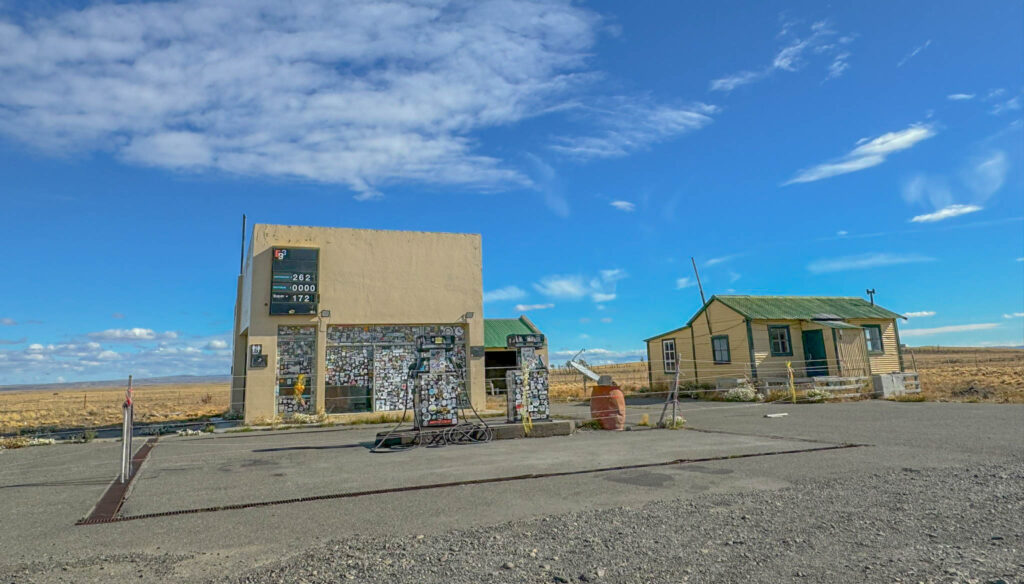
The paved, two-lane road out of the El Calafate city center starts out easy. Be forewarned that you’ll be crossing a DUI checkpoint (located between the El Calafate city center and the El Calafate airport), so you’ll want to make sure you’re completely sober before leaving town.
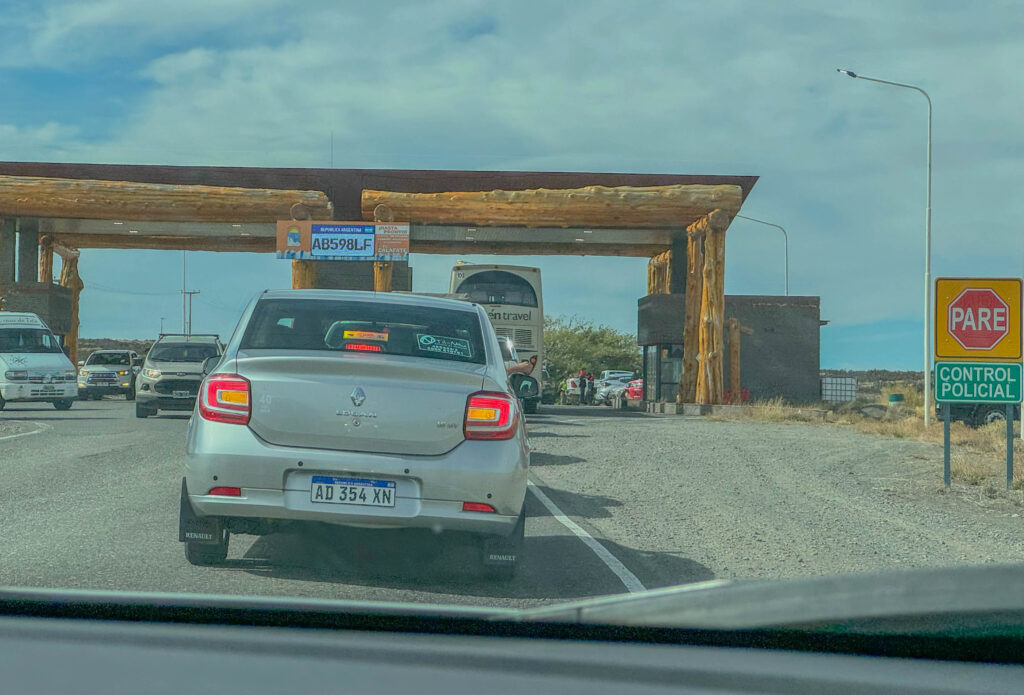
One you’re past the police checkpoint, civilization quickly disappears and you’ll find yourself surrounded by the barren landscape of Patagonia. As the road begins to gradually climb, you’ll be rewarded with some terrific views. If you’re lucky enough to travel on a clear, sunny day, then you’ll be able to see the mountains around the small town of El Chalten (including Mount Fitz Roy) in the distance.

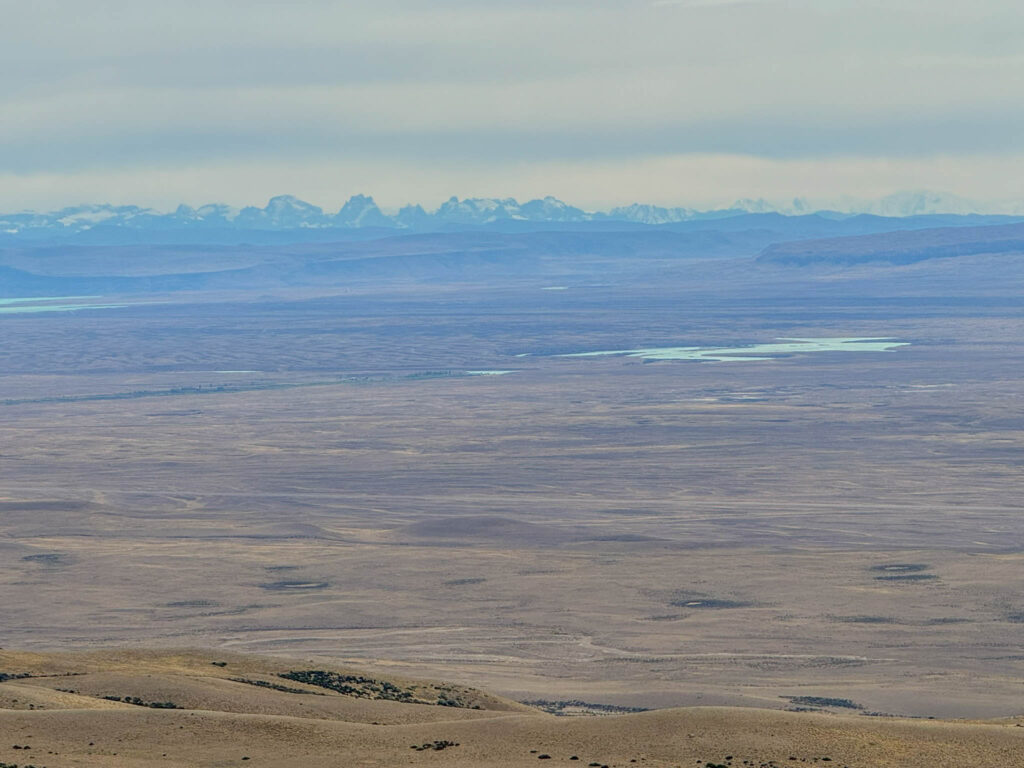
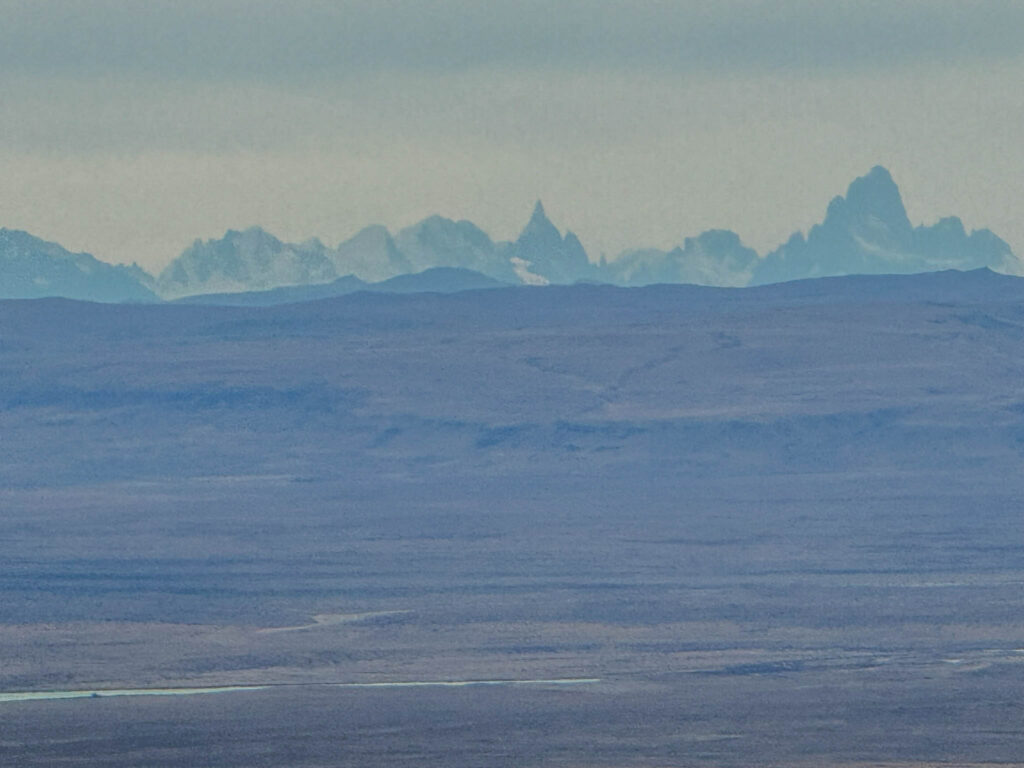
About an hour later, things got interesting. We were making good time on National Route 40, a famous highway similar to Route 66 in the United States. National Route 40 (aka Ruta Nacional 40, RN40 or Ruta 40) runs parallel to the Andes Mountains from its southern terminus in Río Gallegos to Argentina’s northern border with Bolivia. The total distance of RN40 is 3227 miles, making it significantly longer than the 2,448 miles of Route 66 in the United States, but shorter than the 4,645 miles of the Trans-Canada Highway.
We were cruising along nicely when Waze and Google Maps suggested we turn off National Route 40 and take another road that appeared to be unmarked, other than a sign indicating it was headed towards our destination in Chile. We confirmed on a map that it appeared to be a shortcut, so we decided to take the turn. The next thing we knew, we were on a rocky, dirt road, and there was an ominous figure standing at a fence next to the road.
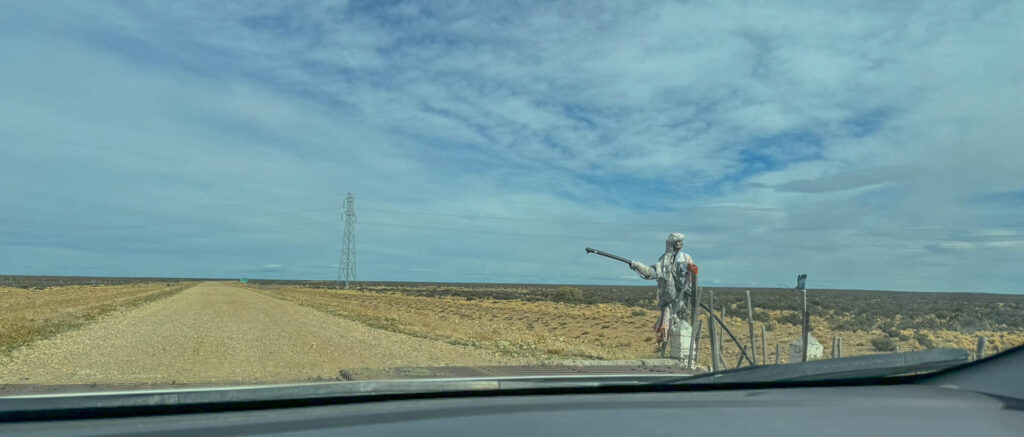
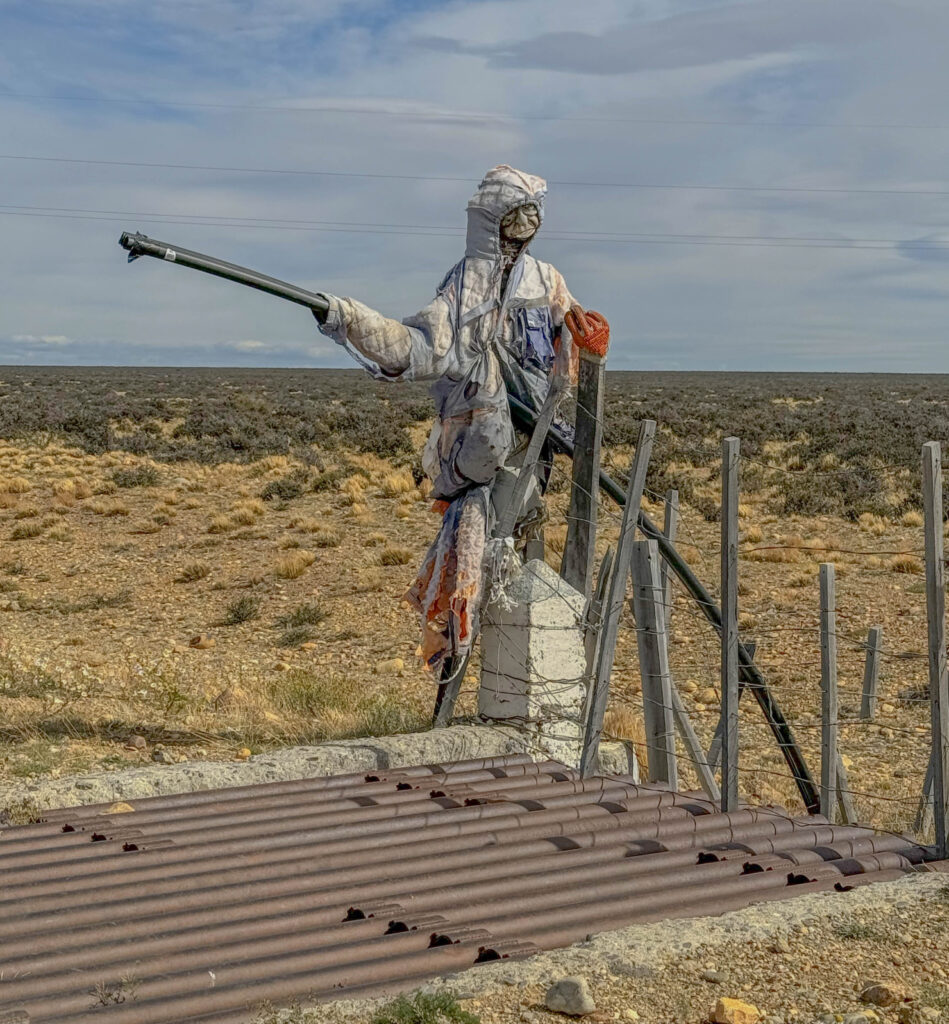
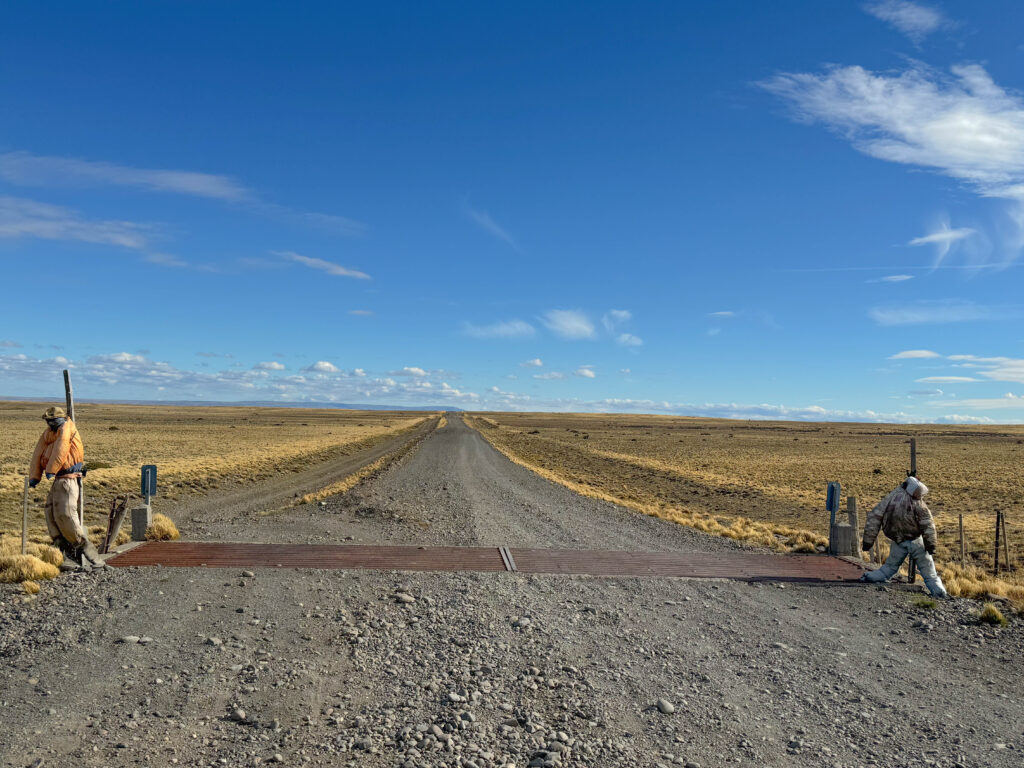
After spending about five minutes on the rocky, dirt road, we decided to turn around and take the longer, paved route. No, it wasn’t because of the creepy figure at the gate. We were worried about getting a flat tire in the middle of nowhere, since tomorrow was our only chance to do our planned hike at Torres del Paine.
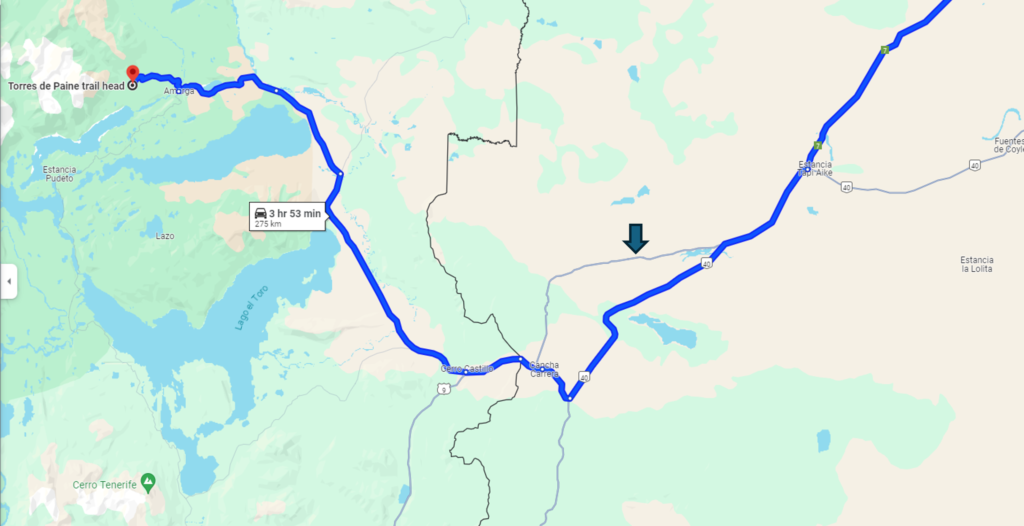
In the end, it took about 30 minutes longer to take the paved route. We know this because we took the adventurous, rocky dirt road on the return trip back from Chile to El Calafate, Argentina.
What’s that dirt road really like? Well, our 2-wheel drive car was able to handle it, but it sure felt like the car was taking a beating from the rough roads. We could frequently hear the sound of dislodged rocks getting kicked up and hitting the bottom of our car. It was definitely not a relaxing drive, as it required constant concentration to avoid larger rocks that our car was unlikely to clear.
The route included one or two SOS towers that we assume includes a phone or some other way to get help in the event of an emergency. But, depending on where your car breaks down, that could make for a very long walk. We only saw two cars during that 40km segment of the drive, even though we were on the road for well over an hour (one-way). And that was during high season for tourism!
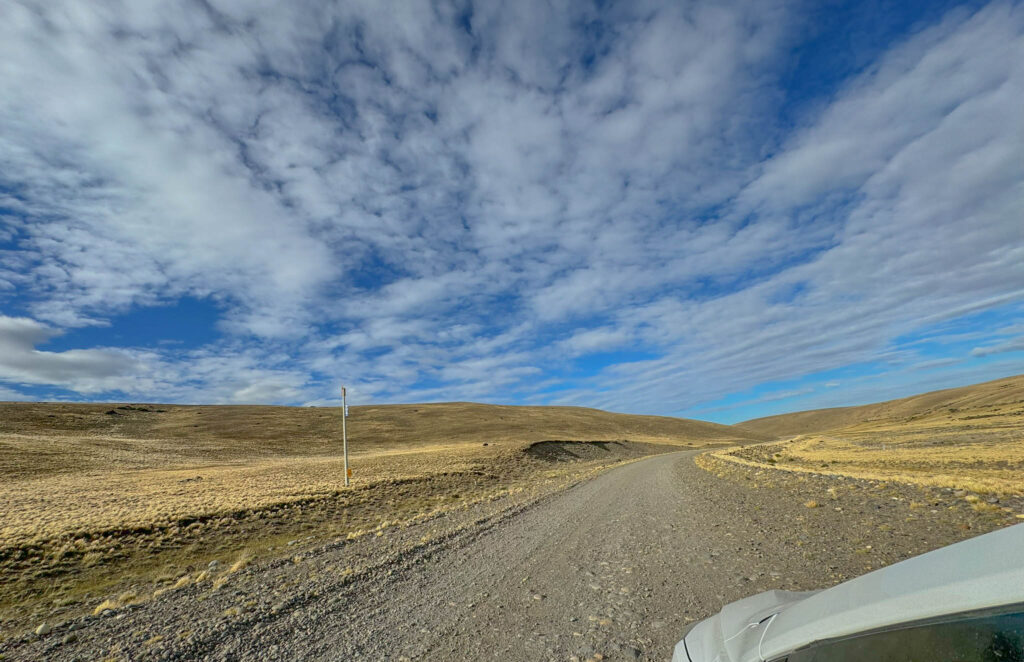
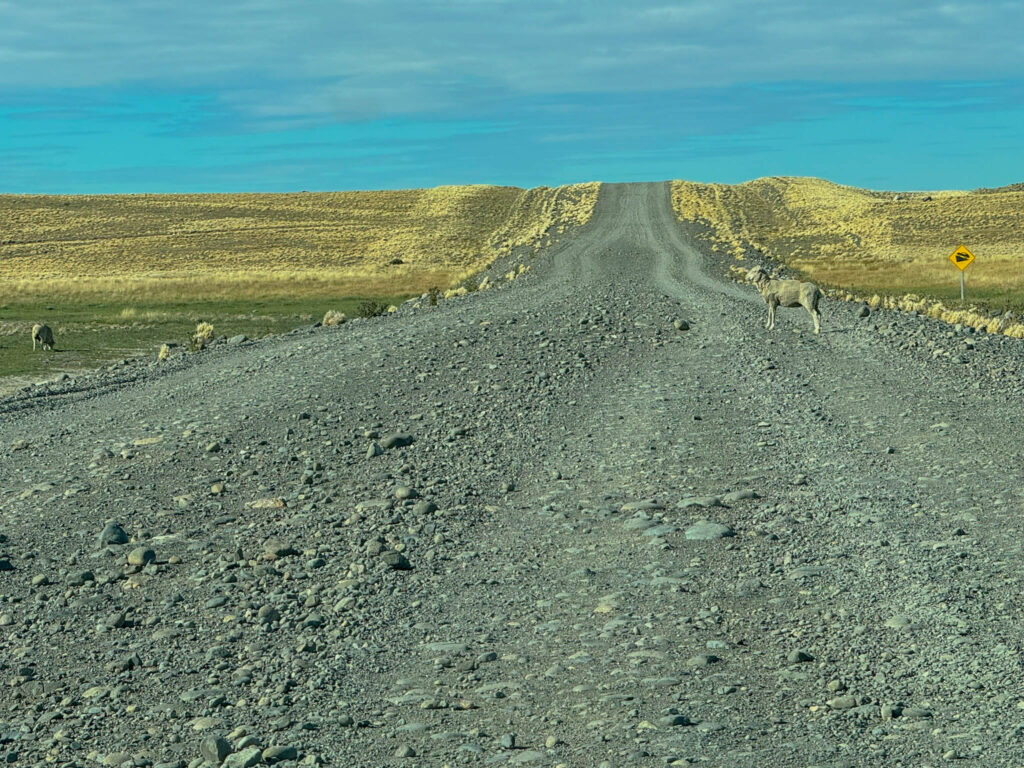
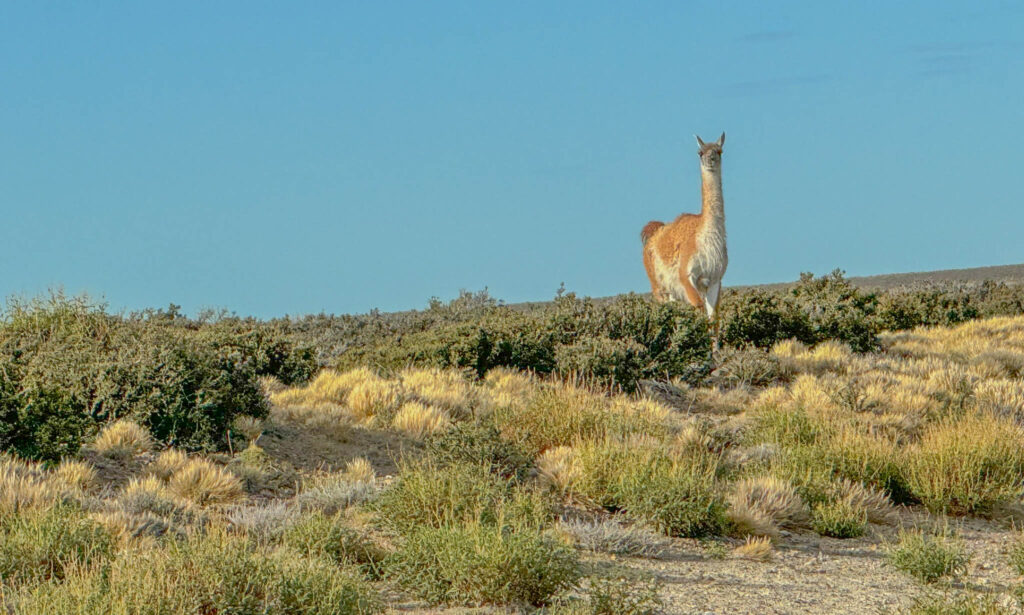
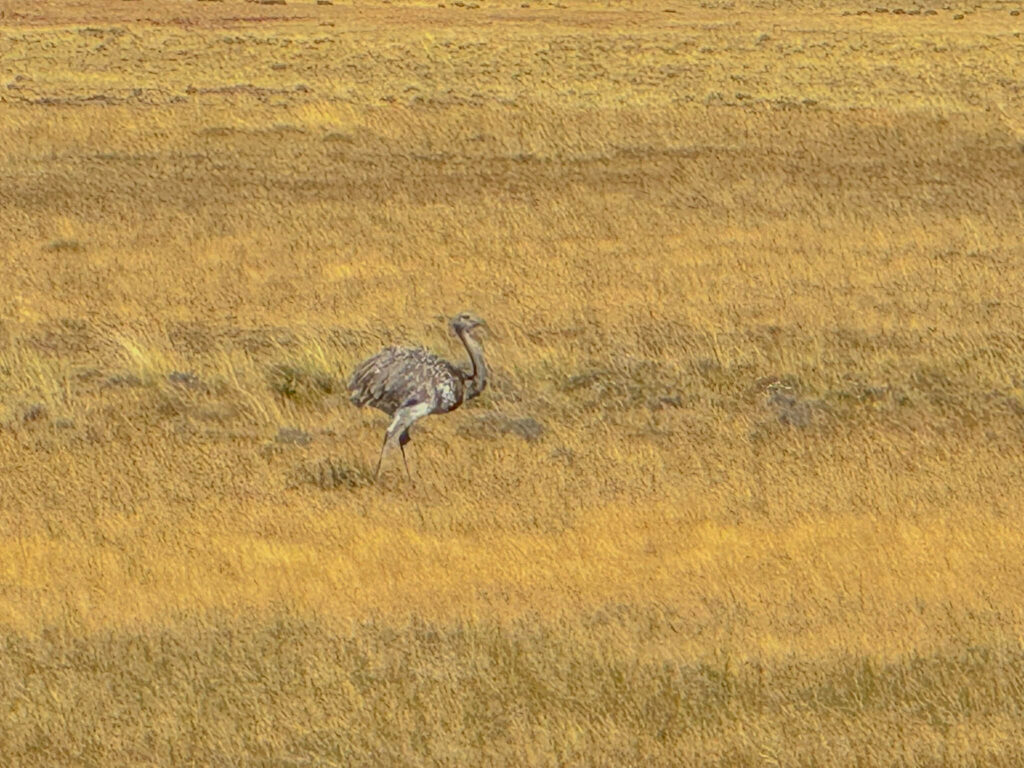
Crossing the border: a confusing process at the Customs offices
Even if you take the paved route towards Chile, you’ll eventually find yourself turning off RN40 to get on a dirt road that takes you to the Argentina – Chile border. However, it’s not nearly as rough as the “shortcut” road. First, you’ll arrive at the customs building on the Argentina side of the border.
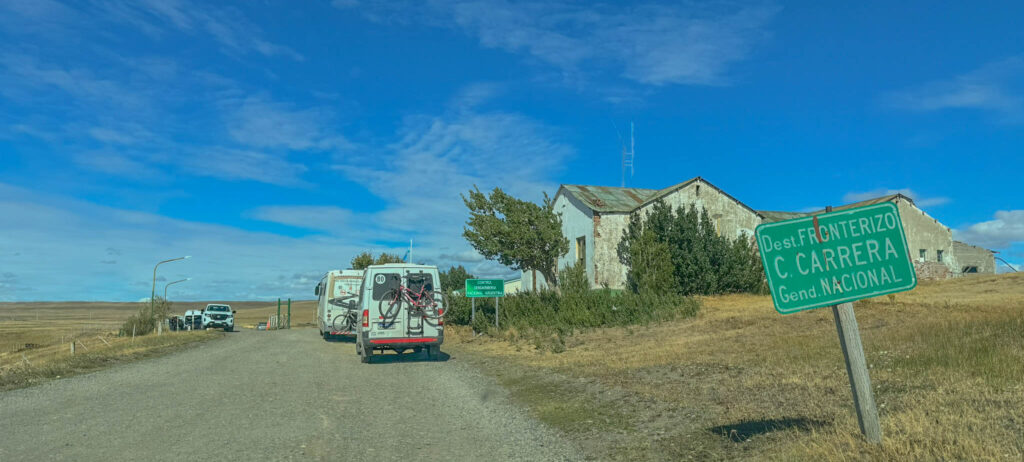
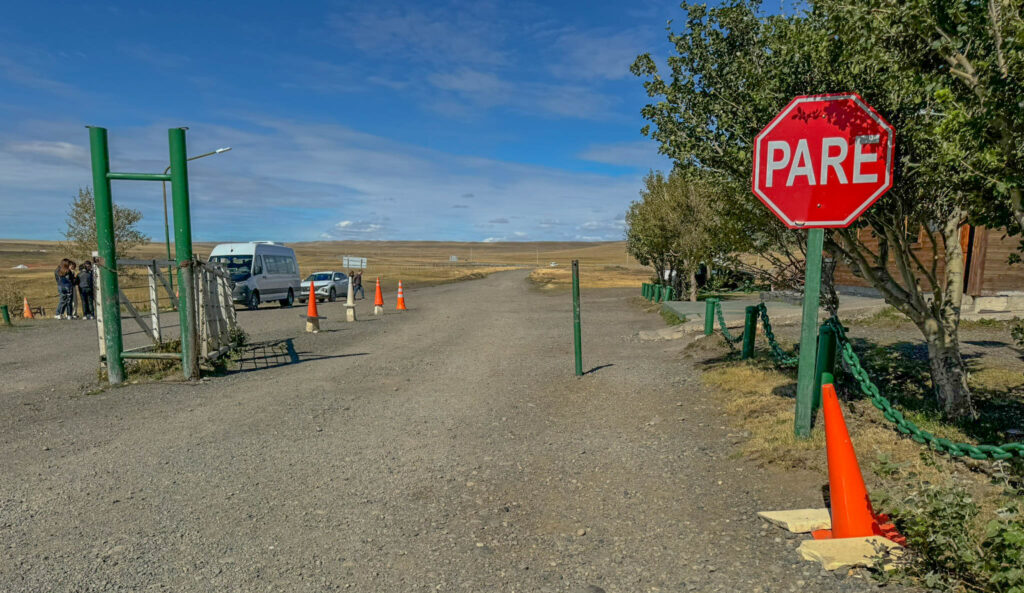
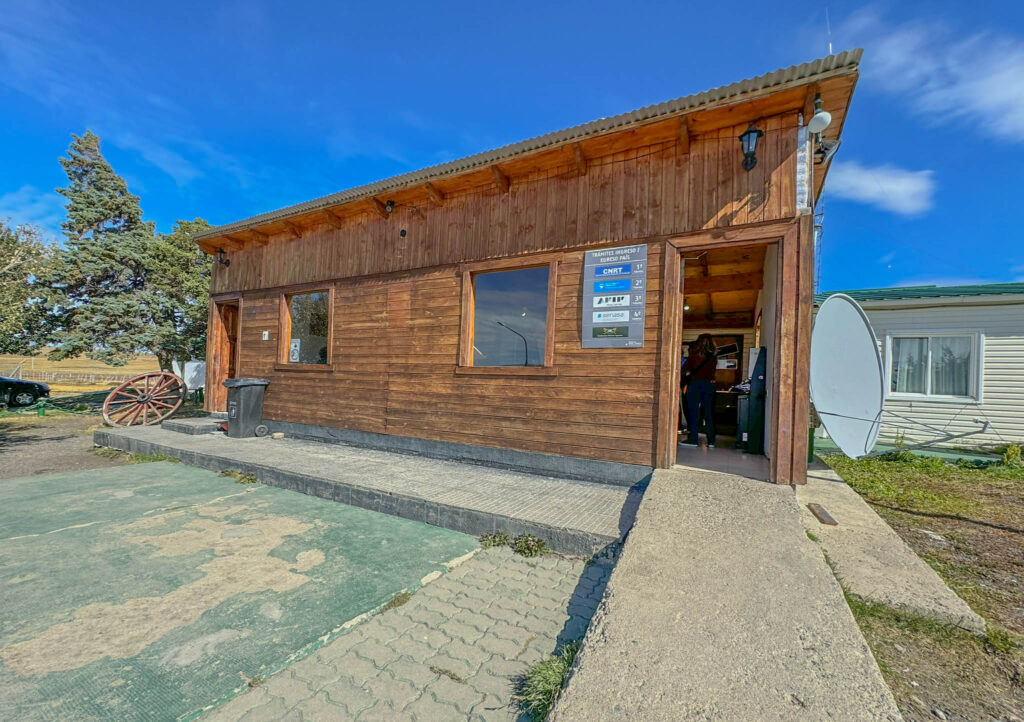
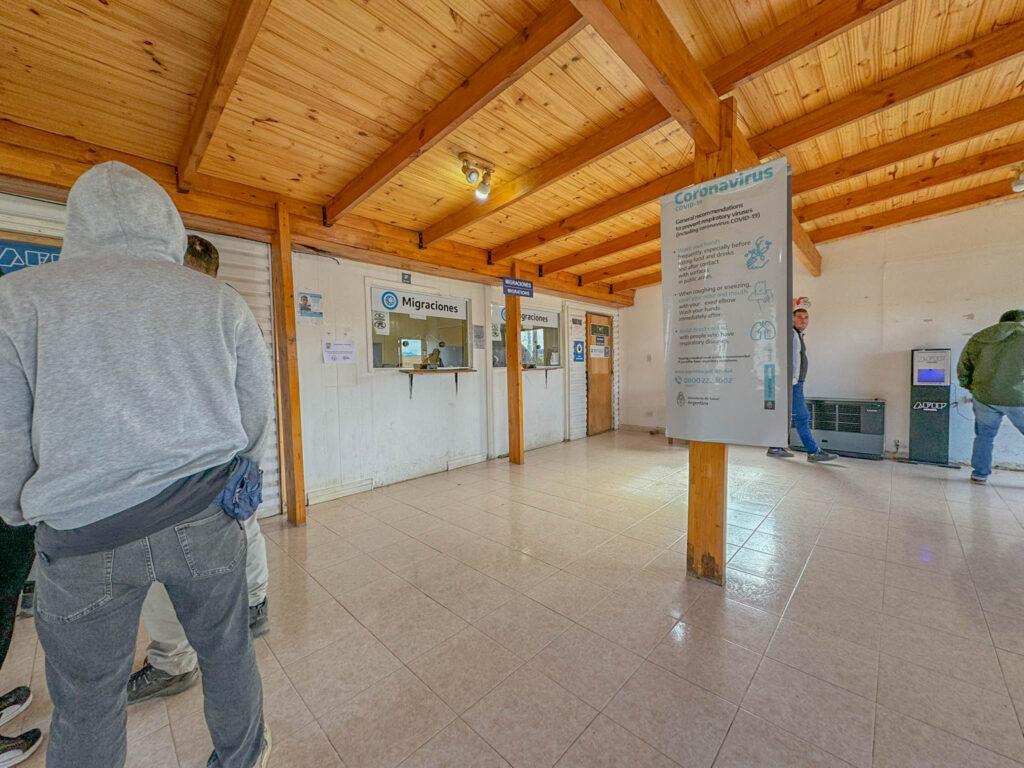
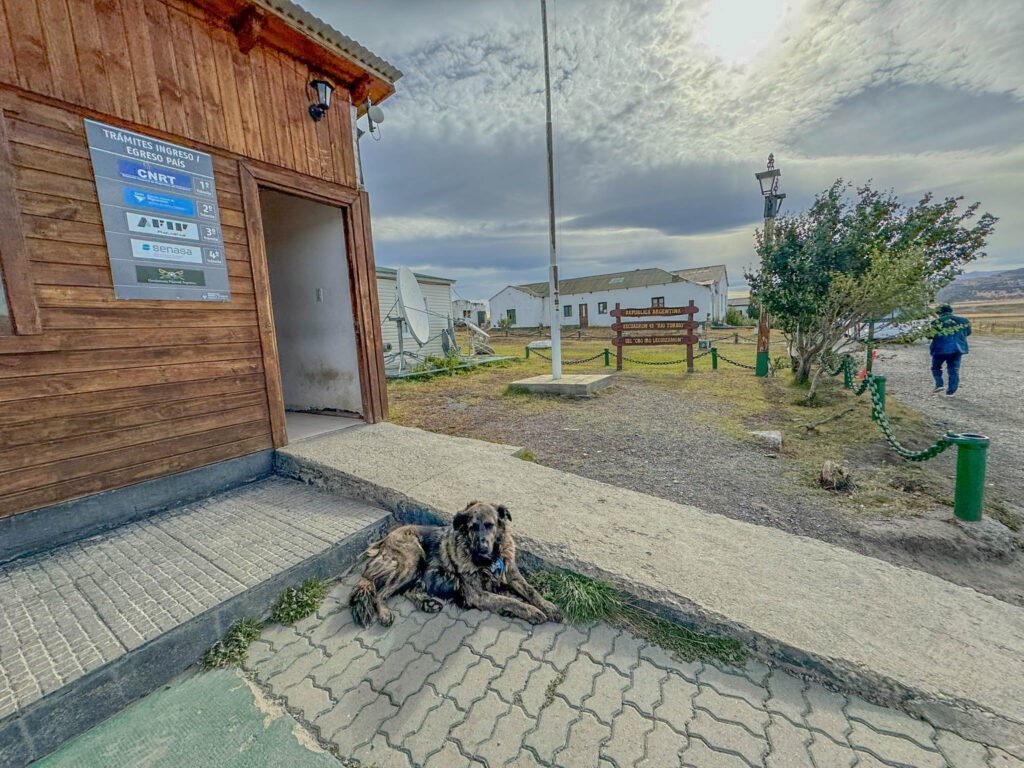
There were only a few other travelers inside the customs building and it didn’t take us long to get our rental car paperwork reviewed, approved, and stamped. By “paperwork”, I’m referring to our passports and the documents we received from the rental car company (when picking up the car) that permitted us to take the car across the border multiple times.
After getting the necessary approvals from the Argentina customs office, we hopped back in the car to drive into Chile. We noticed that the road was suddenly paved on the Chilean side of the border. Perhaps Chile is trying to one-up Argentina. Regardless, it was nice to be back on a paved road. That transition from dirt road to paved road can become an issue when traveling the other direction. Cars may be moving at a good clip on the paved road when, all of a sudden, the pavement ends and you find yourself on a dirt road. That transition from paved road to dirt road can easily take you surprise. Here’s a case in point.
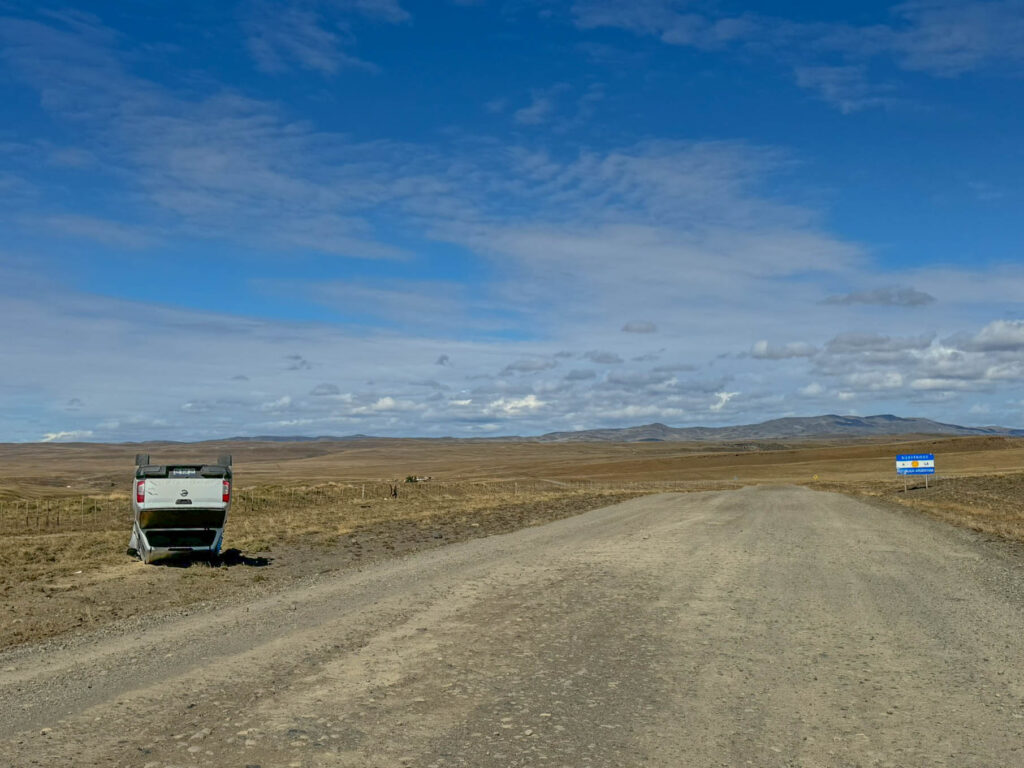
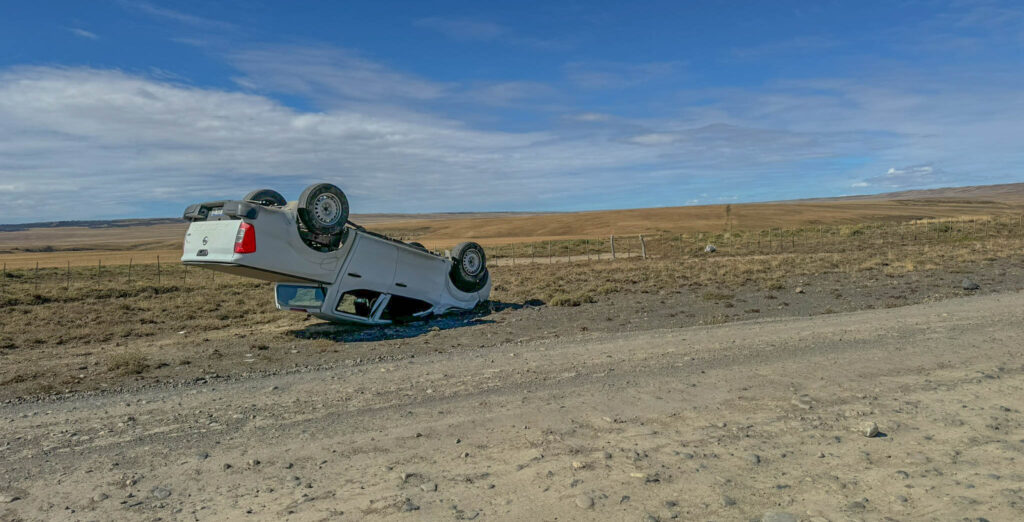
A few miles past Argentina’s customs building, you’ll need to get out of your car again to show your stamped paperwork and passport to the Chilean border staff.
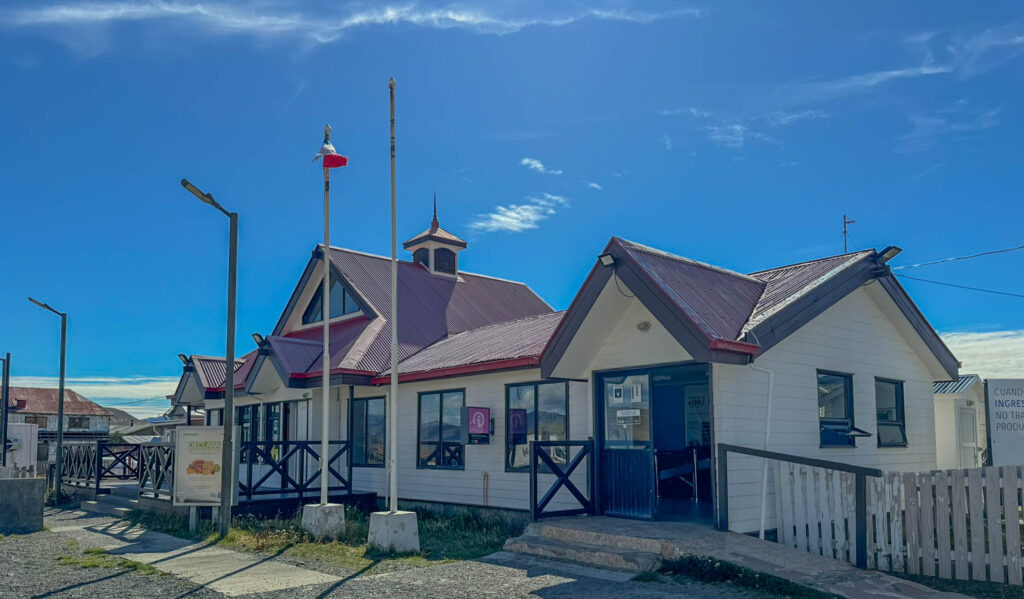
Keep in mind that you may need to get multiple stamps / signatures and will likely need to wait in multiple lines to get everything approved in the Chilean border office. During our return trip from Chile back to Argentina, the instructions were not clear, and the staff were not very friendly or helpful. As a result, we only waited in one line and got one set of stamps/signatures. We then drove to the Argentina customs building, only to hear the staff tell us that we need to turn around and get another stamp from the Chilean border office. They made us drive back to the Chilean border office to get the other stamps/signatures (one line for your car, one line for you, and one line for customs), and then drive back again to Argentina’s customs office. It’s an inefficient and confusing process, so be sure to ask questions if you’re not sure what to do.
After passing the customs office in Chile, we were happy to be back on paved roads. But then, it was time to turn onto another dirt road in order to get to our AirBnb. Thankfully, that dirt road was smoother and less rocky than what we experienced in Argentina. As we twisted and turned along the dirt and gravel road for another hour, we eventually came to an opening with a great view of our destination: Parque Nacional Torres del Paine.
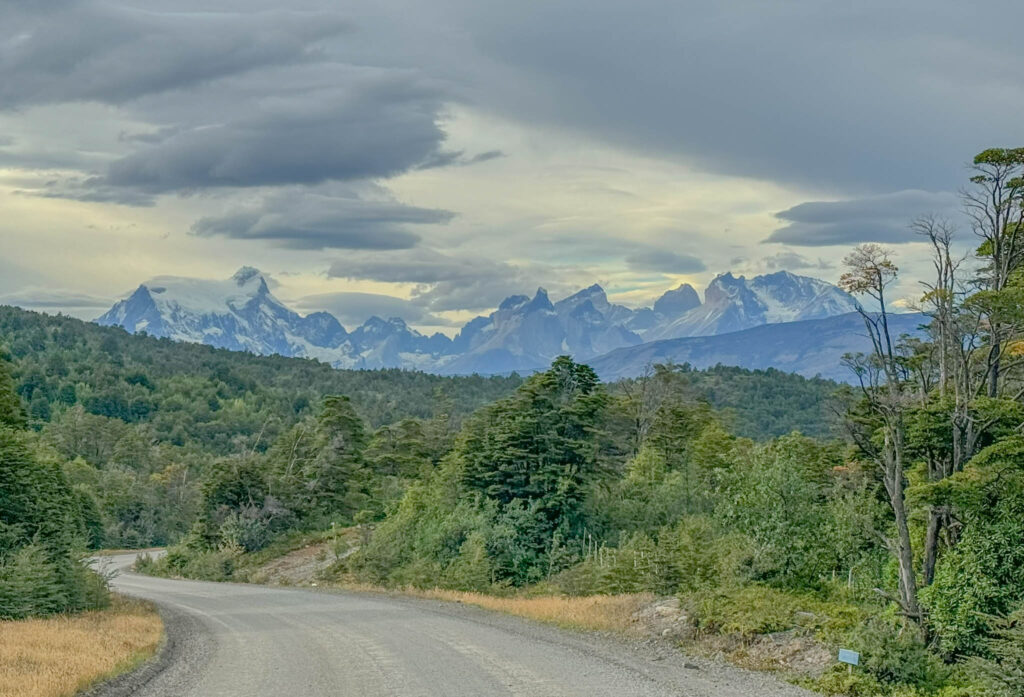
Overnight near Torres del Paine
Finally, after a travel time of 5 hours, we made it to our destination for the evening – an AirBnb located near the Rio Serrano Hotel and Pampa Lodge. To give you a sense of the timing, we left the El Calafate city center at ~2:30pm, made it through both layers of border’s customs buildings at ~6:00pm, and arrived at our AirBnb at ~7:30pm.
As we pulled up close to our AirBnb, we were greeted by a flock of upland geese. I much preferred this greeting over the horror film greeter that we saw on the shortcut road earlier that day.
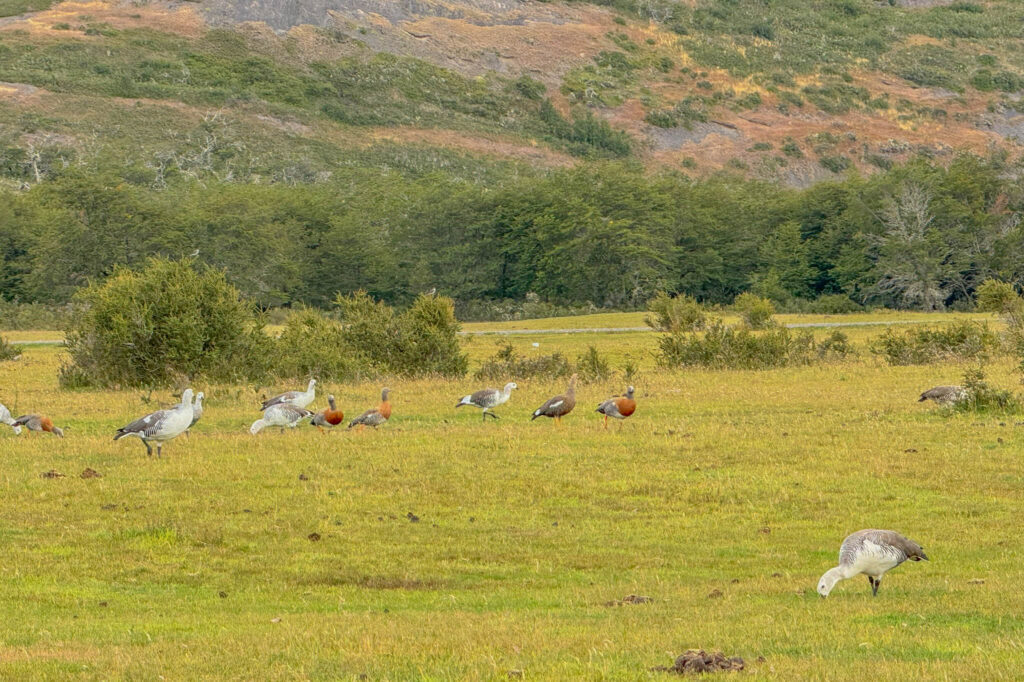
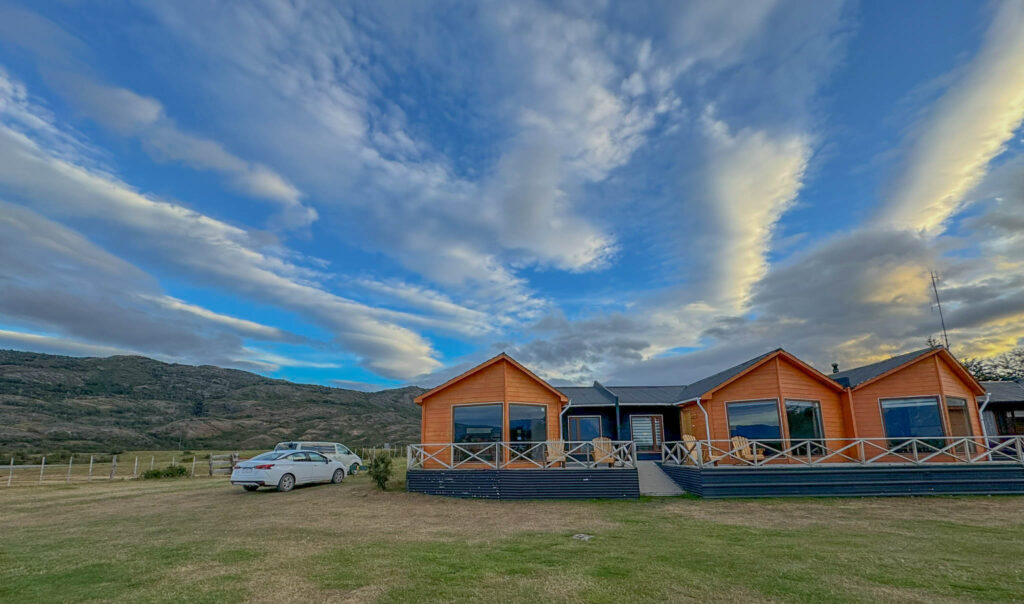
The views of Torres del Paine from our AirBnb were impressive:
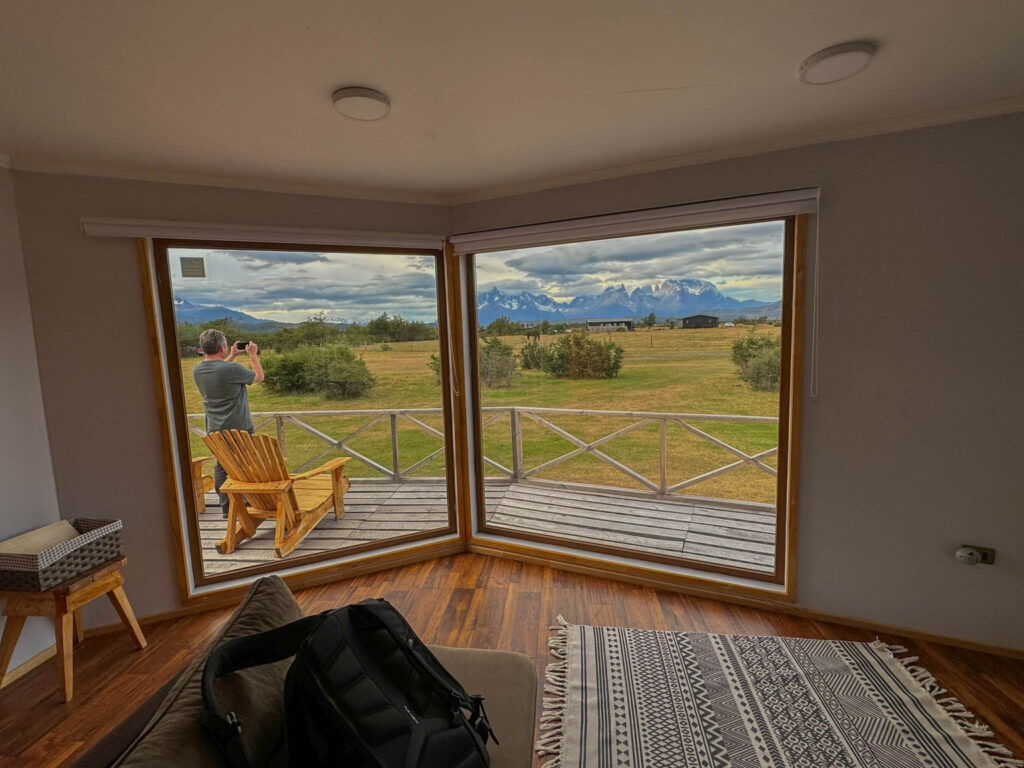
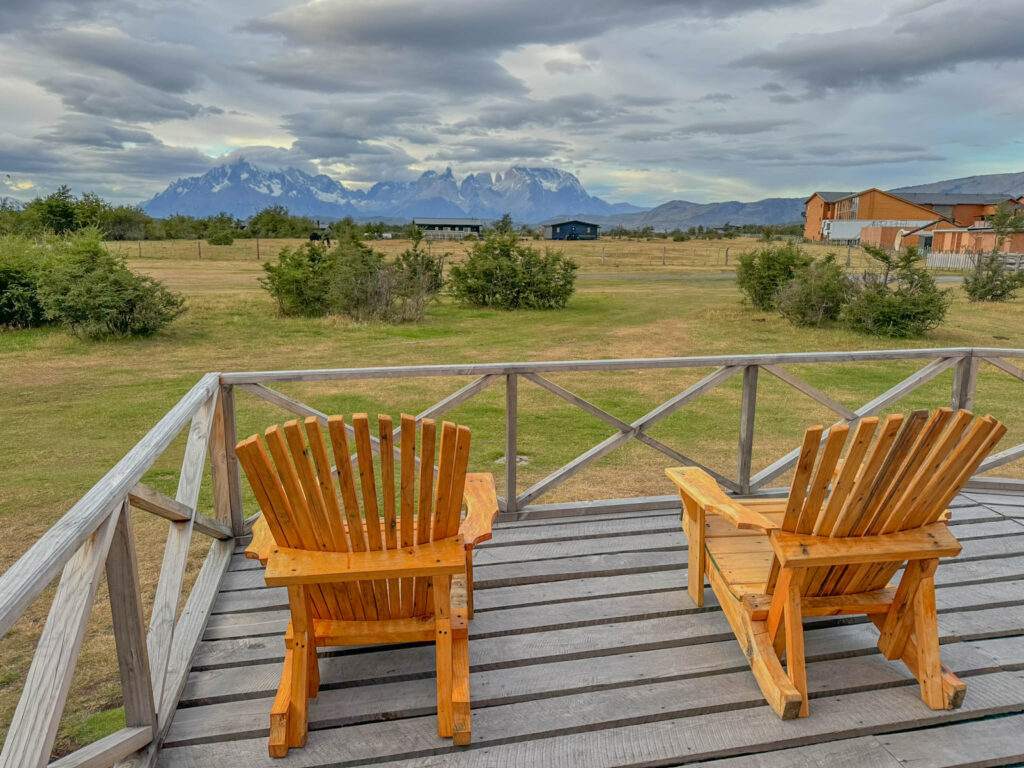
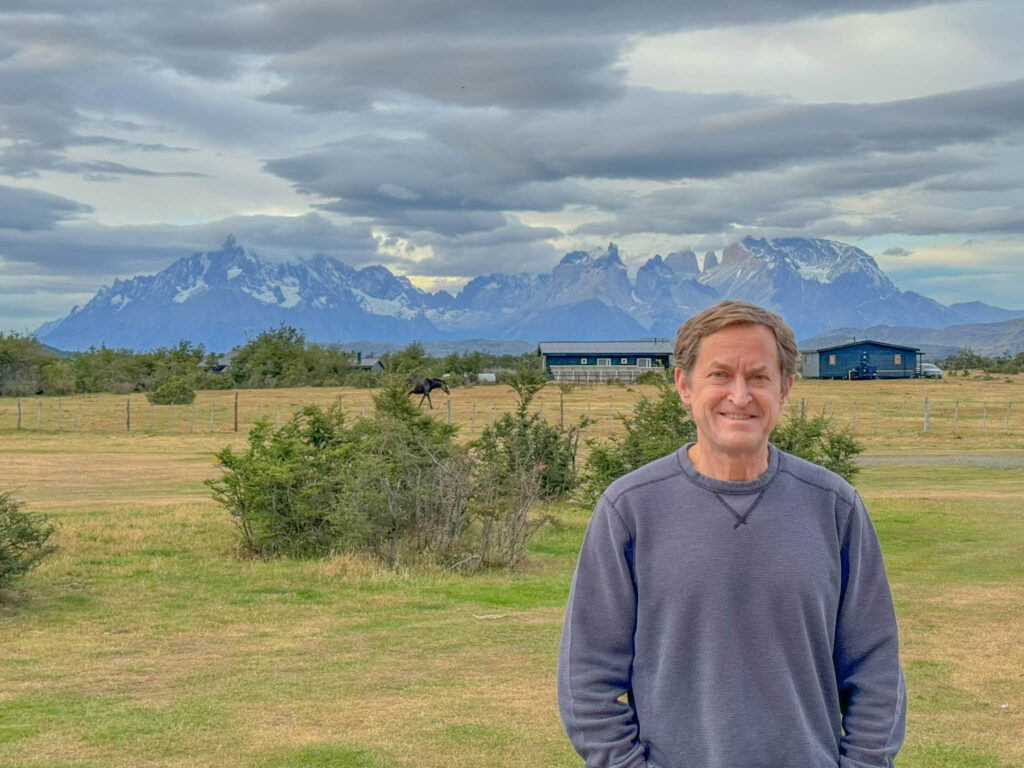
We decided to walk to the upscale Rio Serrano Hotel to have dinner, as there didn’t appear to be any other dining options. When we arrived at the hotel dining area, I asked about getting a table. The hostess asked if I was a guest. I said no, and she practically laughed at me as if I was a complete idiot for thinking I could eat there without having a reservation or being a guest. She informed me that “the restaurant is only available for hotel guests this evening.” I asked about other options and she suggested we go to the nearby Pampa Lodge, which was also within walking distance. So that’s what we did.
Fortunately, the Pampa Lodge was much more welcoming. The restaurant had an interesting entrance, which included a nice walk on a long walkway through a marshy area.
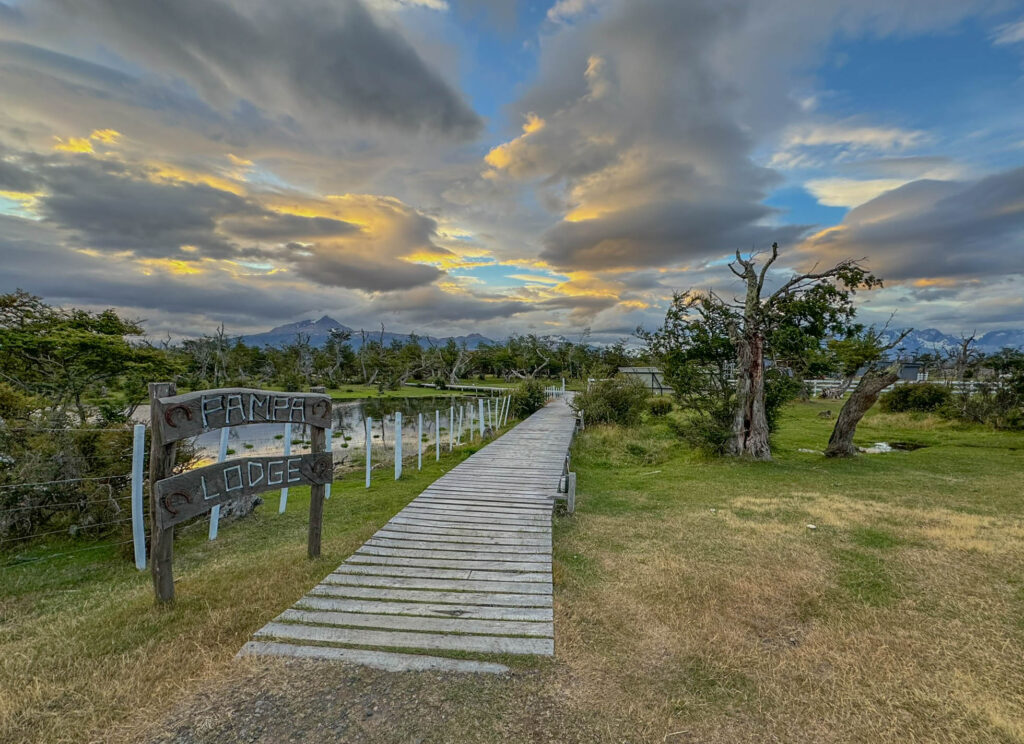
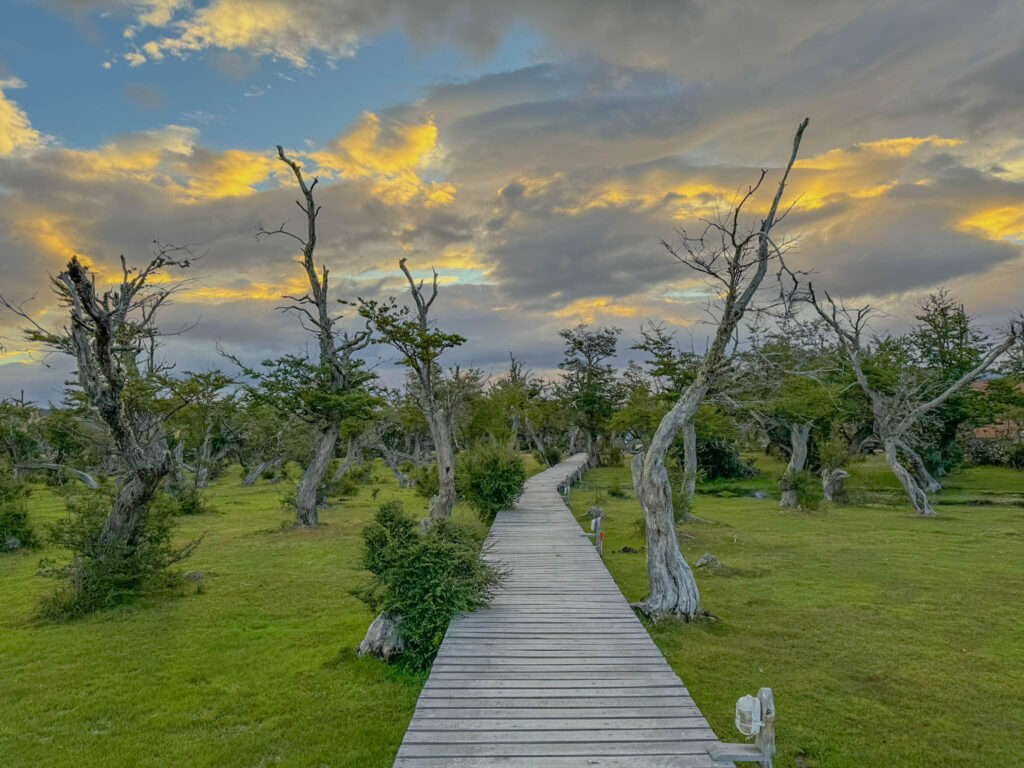
The restaurant itself had a relatively simple menu, and we quickly found ourselves choosing between a hamburger, salmon, or pizza. Not quite what we’d envisioned for a pre-hike dinner, but we were happy to be there.
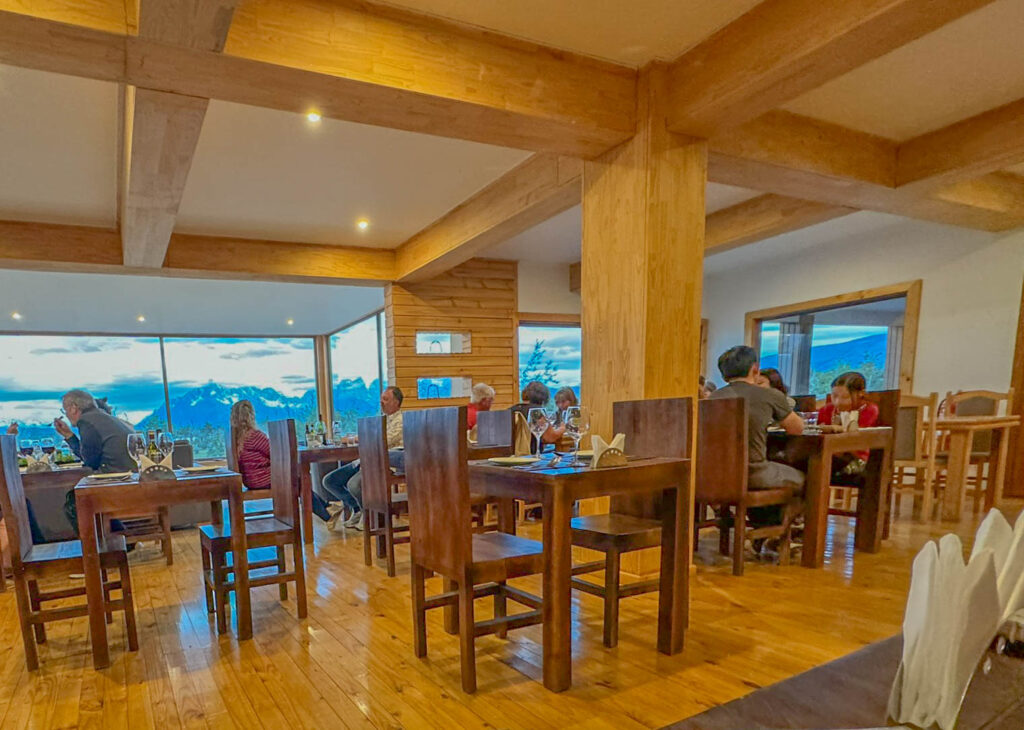
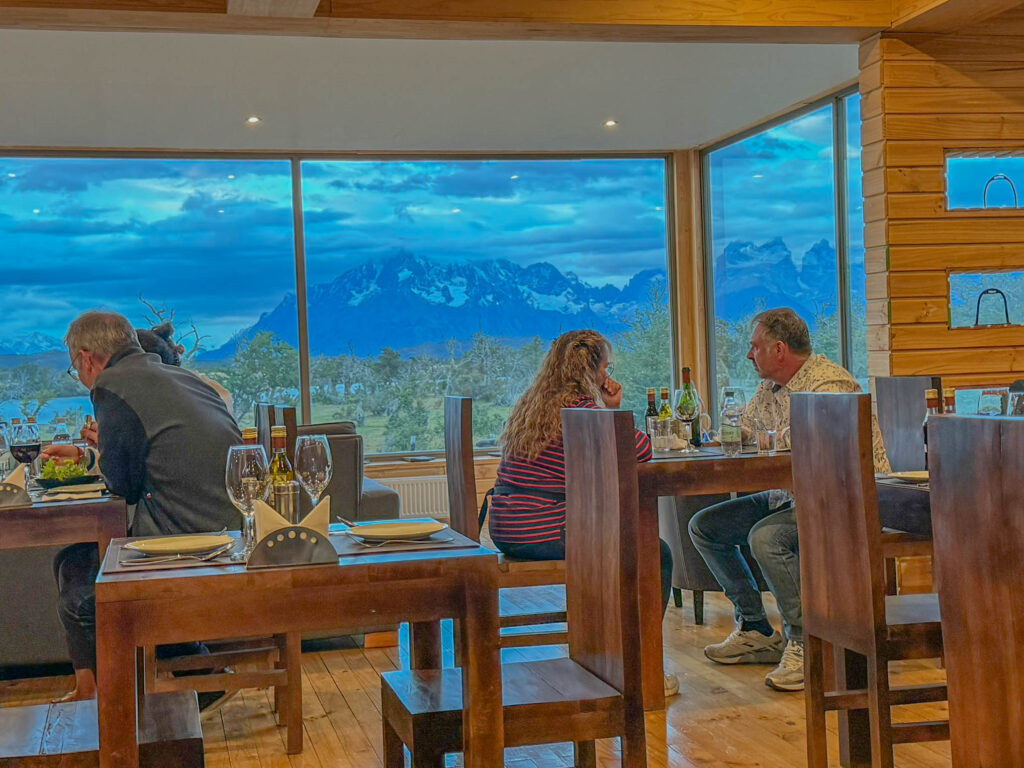
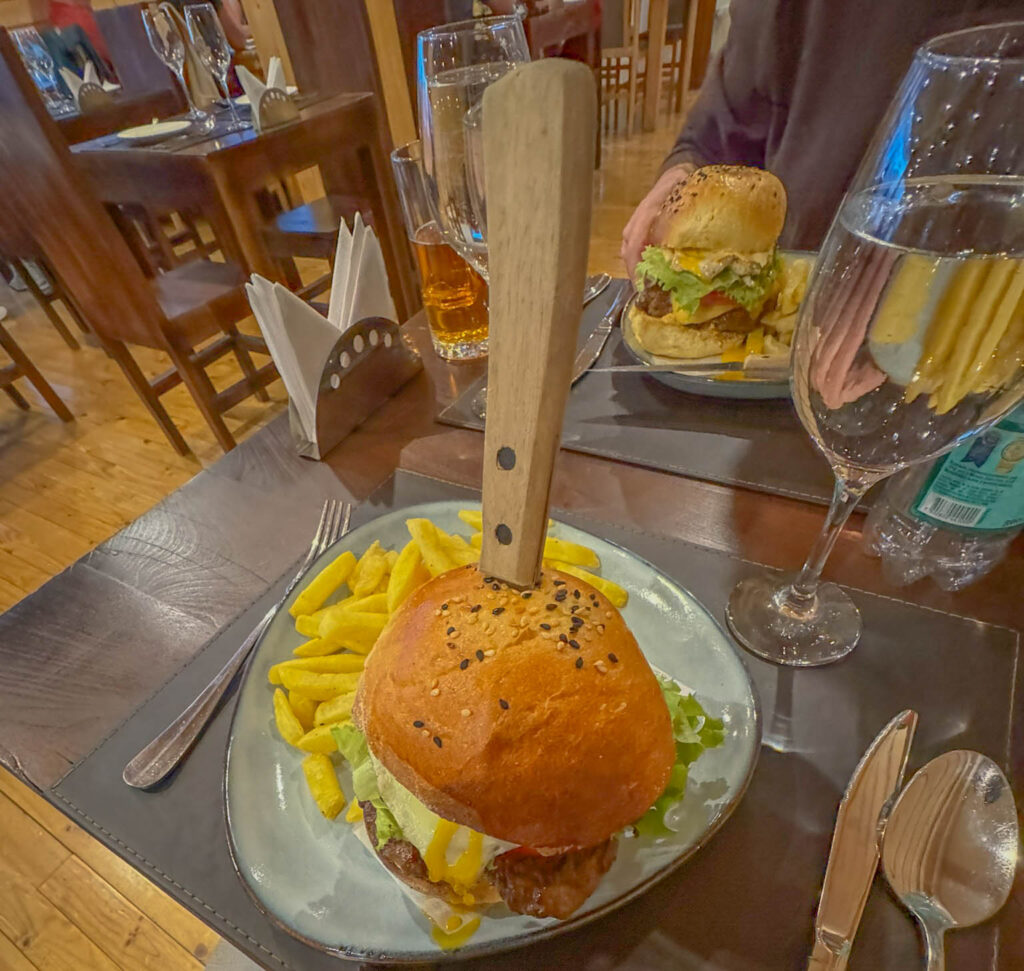
Where to get gas near Torres del Paine?
After dinner, I asked the receptionist if there were any gas stations nearby. The initial answer was “no, the closest gas station is in Puerto Natales” which appeared to be about an hour away. She paused and then added, “but there is a way to get gas here”. I was all ears.
Apparently, she could text a man who was located just 5 minutes away from the Pampa Lodge and he would fill up my gas tank. The price would be $3 per liter, in cash (US Dollars). She asked how much gas we would need, and I guessed 10 liters, although I had no idea how much we needed. She then asked when we could meet the man. Since we planned to get an early start the next morning, I said … how about in 15 minutes or later this evening? She sent another text to the mysterious gas man and received a quick response. “Now is good.” I was very happy to hear that news and agreed to meet him in 15 minutes.
She pulled out a map and described where we needed to go. It wasn’t the easiest place to find in the dark, but we managed to get there. As we approached our destination, a man turned on a flashlight and motioned for us to pull up to a particular spot. There was no gas pump to be seen. He asked (in Spanish) how much gas we needed, and I confirmed 10 liters. The man went to a shed and pulled out two 5-liter containers filled with gas. He also had a funnel with him. So, I opened the gas cap and he inserted the funnel and filled it with 10 liters.
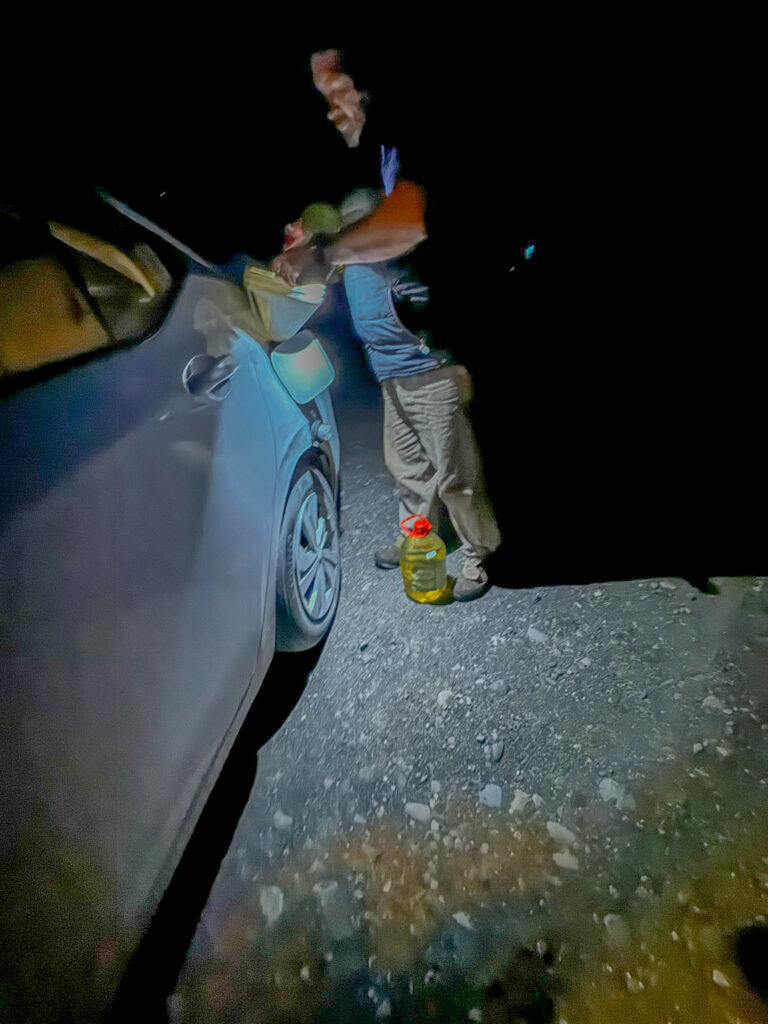
He motioned for me to start my car to check the fuel level. We could still use more, so we agreed on another 10 liters. In the end, 20-liters got us to a safe level of gas for the journey back to El Calafate. We handed him $60 cash, thanked him and said adios. That transaction saved us at least 45 minutes of driving each way (90 minutes round trip) to get gas. Expensive, but we were happy with the purchase. That man must have a good business there, as I’m guessing many people arrive and are much more desperate than we were for fuel.
In Closing
Next week’s post will share what it’s like to hike the world-famous Mirador Las Torres hike in Torres del Paine National Park. Hope you’ll join me then!
Thought for the Week
This week’s thought for the week is in honor of the entrepreneur we met who came up a with a simple business to fill up gas tanks for visitors near Torres del Paine National Park. It’s a good reminder, that an entrepreneurial venture doesn’t need to be complex. It can be as simple as having a funnel and a locked shed full of 5-gallon containers of fuel. He saw a need and did something about it.
“A person who sees a problem is a human being; a person who finds a solution is visionary; and the person who goes out and does something about it is an entrepreneur.”
— Naveen Jain
Thanks for reading and happy travels!
Mark (The New Mexico Travel Guy)

Mark Aspelin, The New Mexico Travel Guy (www.newmexicotravelguy.com), is a travel writer and author of two books who has enjoyed a wide variety of adventures in his travels to over 100 countries and all 50 U.S. States. His current project involves visiting EVERY town in his home state of New Mexico (there’s over 500 towns) and writing a story about each one. He’s on track to finish the project by his early to mid 100s. When not traveling, Mark lives as a recluse in the mountains outside of Albuquerque, New Mexico.
